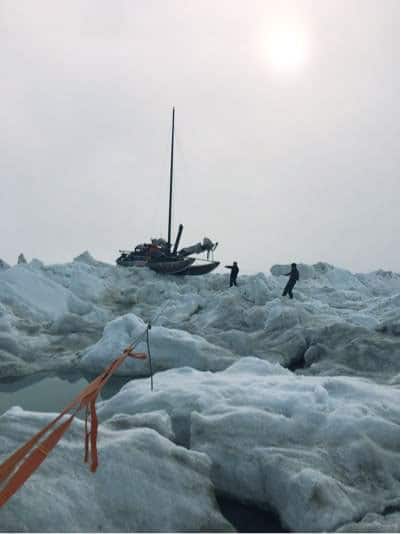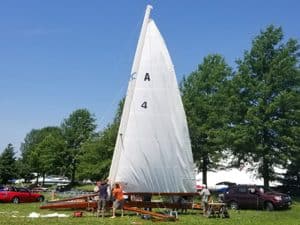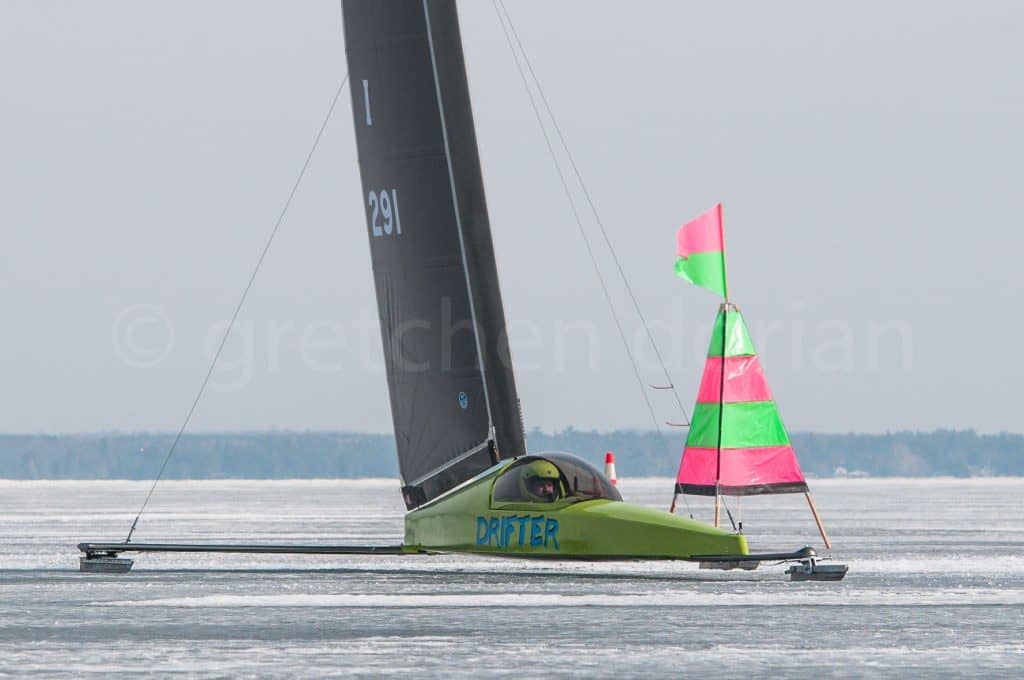Independence Day
Have a great July 4th. Only 150 days until ice making!
Have a great July 4th. Only 150 days until ice making!

While this craft isn’t exactly our definition of an iceboat, it’s July and it’s content for this website. On June 19, three French sailors began an expedition in a catamaran fitted with skis with the goal of crossing the Arctic Ocean via the North Pole by sail and without motor. This is their third attempt since 2011. Their journey will cover 1,1750 miles (3,000 kilometers) between Alaska and the island of Spitsberger in Norway. Here’s their latest blog post:
July 1, 2018: Today, we traveled 1 mile! But we, on foot, a good dozen … Between recognition, hoists, and a few big bags to lug (unloaded from the boat to lighten, pass, then reload) to successfully pass blocks from 2 to 8 meters. But we are satisfied with our day. We are passing the critical part, the big coastal chaos, and it is encouraging to say that we can pass in such corners !! It’s magic, a chaos of ice, with a dim light between mist and sun. Then we have a good team, it works well. Tonight, by the ice ax, we cut into the blocks to create a passage for tomorrow, 100m from here, and then the major ridge will be crossed. We do an ant work, but we move north, where we hope to find water and increase our daily progress.
Follow their journey “La Voie du Pole” here.

Iceboating weather can be extreme, but usually on the cold side. The MARY B group met on Friday, June 30 (on a day that the National Weather Service issued an excessive heat warning) to set up the historic stern-steerer. Their goals were to practice efficiently setting up the boat, to put up the newly cleaned sails, and to assess the boat. Despite the heat, a big group pitched in to make easy work of it. The new sails and the bright chrome made for an impressive sight.

Minnesota ice sailor, Pat Heppert, has put his virtual drafting pencil to paper and produced AutoCAD plans for his C Skeeter build, DRIFTER. Download them here.
It seems like many people have asked me for plans for my current iceboat, which has been kind of partially drawn up for a few years. So I have finally taken the time to fully detail out the entire boat. The goal of this is NOT to profess any sort of iceboating wisdom, just simply to try to get more people interested in building and continue enthusiasm in the sport. It ended up being 29 pages on 11 x 17 paper. The plans and building guide are now posted in a public folder on Google Drive per the link below. You should be able to download the files with the link below; if you have trouble let me know. The plans are in PDF format as well as AutoCAD format. The AutoCAD format can be viewed and printed with a free viewer program downloadable from Autodesk.
Pat Heppert
 Lake Winnebago stern-steerer sailors Andy Gratton and Mike Kroll might still be on the search for ice so that they can add to their 1000 mile season. Ice is rare this time of year but they did drop in to visit with an iceboater from Lake City, MN.
Lake Winnebago stern-steerer sailors Andy Gratton and Mike Kroll might still be on the search for ice so that they can add to their 1000 mile season. Ice is rare this time of year but they did drop in to visit with an iceboater from Lake City, MN.
“Mike Kroll and I were in Rochester and stopped to see Bruce Eggenberger, a long-time stern steerer sailor at Lake City. He had this photo from his uncle who used to ice boat there.
The story is that most of these boats were all stored in the same barn. Some irate wives of the iceboaters burned the barn one night. Silly them, they didn’t realize the boats were keeping their husbands out of the bars. I bet it was Bob’s wife because he didn’t name the boat after her”.
In a related story, a few years ago, Harry Allen sent a link to this Lake Minnetonka Magazine article written about the iceboating scene on Pepin and Minnetonka in the 1890s. The story details a race between the Pepin and Minnetonka stern-steerers with the winning skipper of the race being a 17 year old girl, Nancy Bassett.
Frank Trost, along with his neighbor William Perrigo, was another legendary E Skeeter sailor from Pewaukee, WI. Trost and Perrigo captured the 1953 Ice Yacht Challenge Pennant the first time the race was held in the Midwest after Fox Lake’s Eddie Rollberg won it out east in 1952. Trost was part of the winning team that went on to win it another 3 times.
Frank Trost gave one of my favorite descriptive quotes about ice boating to a Russian reporter in 1960:
From “Sailing In the Cold Region“, a Russian magazine article published in 1960:
Frank Trost, Perrigo’s neighbor, describes even poetical a ride on his “Tuscarora”:- Iceboat comes alive, he begins to talk to you. Was I somehow on Lake Delavan. Gusts crosswind reached 80 km / h. I didn’t feel under itself, but the “Tuscarora” didn’t obey. It seemed to fly through the air; only the wind howled in the wires and whistled – people standing on the bank told us that the boat roared like a jet plane – and in my helmet was a rumble that I have not heard the creaking of the runners. After the arrival, from flying in all directions icicles Trost’s face was covered with hundreds of tiny cuts. But the little things it did not disturb. As many iceboat sailors, he doesn’t recognize the face masks. He argues that in order to determine the speed of a good sailor should feel the wind on his face and trap slightest changes, skillfully using them to speed up the movement. It is worth and cause injury to the blood!